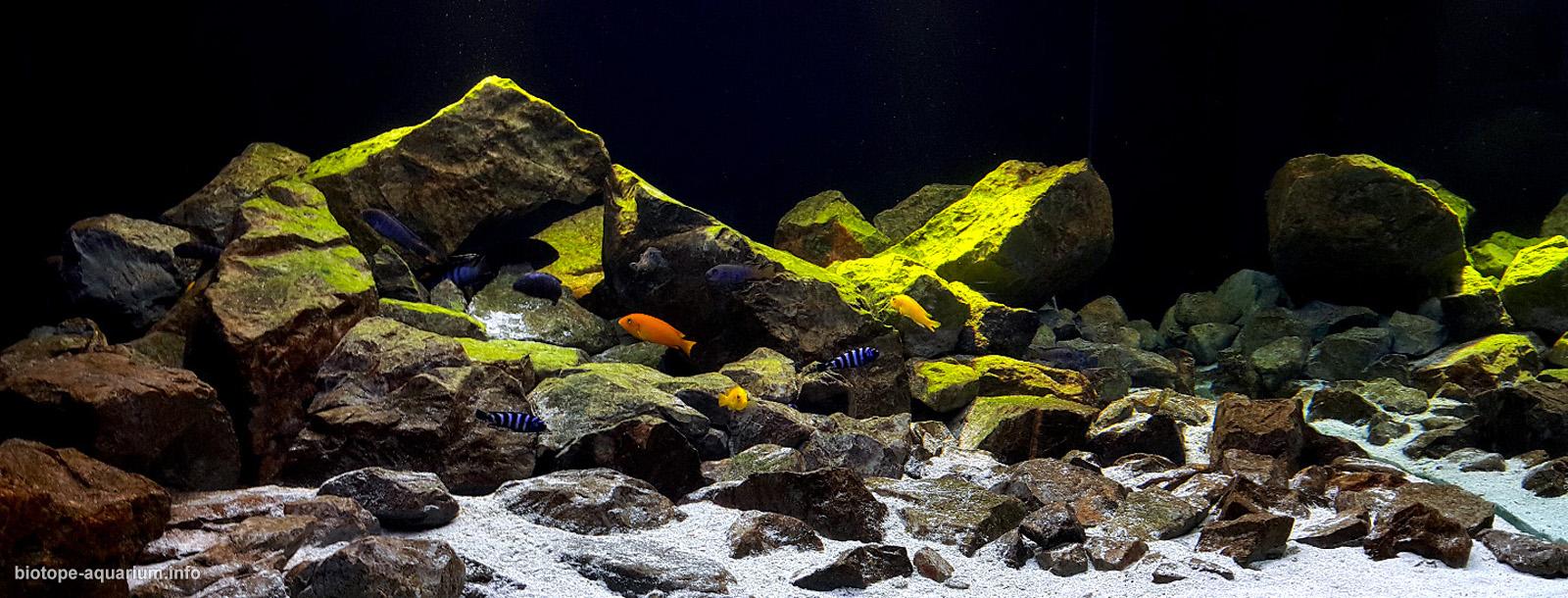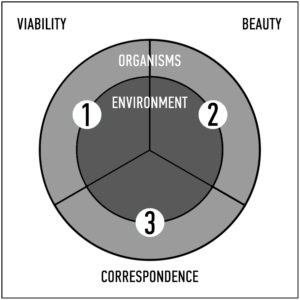What a biotope aquarium should be?
What aquarium can be considered a biotope? Not only beginners, but also experienced in this subject aquarists ask this question. I cleared it up a little in a special article, however, for a deeper insight into the subject, I suggest you to read this informative article.
First of all, to understand the evaluation system, you need to answer the question: what should be an aquarium, in particular, a biotope one? Let’s look at the basic criteria according to which biotope and other aquaria should be to evaluated.
Criterion 1. System viability
An aquarium is a mini-ecosystem consisting of the habitat (soil, decorations, shelter, chemical and physical parameters of water, lighting, etc.), as well as communities of living organisms, from microorganisms in the soil to plants and fish. In order for the system to become viable, all components should be selected competently and match very well.

The better this work is done, the more stable the aquarium is, and the less care it will require from its owners. This rule is valid for all types of aquaria: planted, biotope, and aquascape. It is desirable to select the inhabitants for the aquarium, taking into account their natural needs in free space, shelters, lighting, water parameters, etc., since in nature they live in their unique conditions: biotopes. Make sure your aquarium meets the following requirements:
- The volume and proportions of the aquarium correspond to the specified species composition, amount and size of hydrobionts.
- The space created with the help of decorative elements (including plants, if available) is suitable for the selected community of hydrobionts. If necessary, there are shelters and free zones for swimming in the aquarium.
- The characteristics of decorative elements correspond to the vital needs of organisms. For example, for plants and fish, the correct form and fraction of the soil is selected, stones and soil do not have cutting edges, there is no excess of organic deposits in the aquarium.
- The composition of the aquatic organisms is correctly selected from the point of view of their compatibility. Predatory, aggressive and herbivorous specimens do not threaten other species of animals and plants. Otherwise, in the description of the aquarium, it is necessary to explain how the viability of the system is achieved.
- The appearance of fish and plants shows that they are not sick. The aquarium should look stable, with no excess of suspended matter and algae. Exceptions may be cases when it is vital for selected species. In the description of the aquarium it is important to indicate how the specific water parameters are achieved. For example, increased hardness or reduced pH.
Criterion 2. Nature beauty of aquarium
So that aquarium will look nice, its filling should be selected and arranged beautifully. To do this, it is not necessary to put colorful colored gravel and plastic castles in it. Nature itself gives us enough examples of beautiful underwater landscapes, often not worse than above-water ones. Why not learn from its harmony, but at the same time make inhabitants of the aquarium feel at home?
Biotope aquarium is not a reservoir with muddy water and a bunch of chaotically placed branches and leaves. In nature, there is something more interesting, and it is necessary to copy beautiful parts of biotopes. Also an important aspect of the perception of a biotope aquarium is an effect of presence in the natural habitat. This effect is created not only by decorations and soil, but also by correctly planted plants and the natural behavior of fish. Thus, a biotope aquarium is considered beautiful if:
- The layout of decorative elements used inside the aquarium is balanced.
- The visual atmosphere of the aquarium creates a sense of presence in the natural habitat.
Criterion 3. Conformity to natural habitat
Finally, we have approached to what distinguishes biotope aquaria from others, namely the correspondence with the natural prototype. And this correspondence can be performed in the aquarium only partially. The more correspondences there is, the more possible it is to call the aquarium biotope.
How to determine the degree of correspondence of the aquarium to a certain biotope? Of course, on the basis of reliable information, which can be found on the Internet, books, magazines, or exploring the biotope. If you are planning to participate in the international Biotope Aquarium Design Contest, be sure to record all the data in the form of a biotope description and provide the organizers with a link to the sources of information: blog entries, articles, photos, videos. This will provide you with conclusive evidence and guarantees a high points.
What should the jury members take into account when evaluating by this criterion:
- Species correspondence of hydrobionts to the habitat specified in the description.
- Visual correspondence of the decorations and their arrangement to the specified habitat.
Criterion 4. Quality and reliability of information about biotope
The very words “biotope aquarium” say that such a home reservoir should be set up on the basis of a natural prototype. But this does not mean that you have to go to South America and collect the necessary species of fish, decorations and water for aquarium. It is enough to study the research of professionals and amateurs in books, magazines, websites, blogs, photo, video galleries, and on their basis to create a piece of nature, as close as possible to a natural prototype.
The participant of the contest should correctly arrange information about the natural habitat. It should include:
- A correct name consisting of: the visual characteristics of the biotope (1), the type and, if available, the name of the reservoir / watercourse (2), the toponym indicating the exact location of the biotope (3), the name of the country where the biotope is located (4). Example: Wetland (1) backwater (2) near the mouth of the Yangtze River (3) in Hunan Province, China (4).
- Description of the underwater landscape. What forms the underwater picture? Is it stoney rocks or a lot of driftwood, fine sand or silty sediments? All this is important to indicate in the form. Example: A river passes through limestone and sandstone, therefore it carries a variety of stones. The substrate consists of fine sand of a reddish color, although larger rocks are predominantly yellowish white. As the river passes through a dense forest, there are many branches and driftwood in the water.
- Description of the characteristics of the habitat. All information that is useful for recreating the correct habitat for aquatic animals will be taken into account during the evaluation. For example: Water is transparent. The average temperature is 9.5°C, but in the summer it is 18°C. pH varies from 7.6 to 8.1 depending on the season. TDS is 235.
- List of hydrobionts. Specify all aquatic inhabitants (fish, plants, invertebrates) living in the biotope you selected, along with those you use in your aquarium.
- Description of the environment surrounding the biotope. It’s no secret that the underwater biotope is affected by its location and the environment. Whether a river flows through mountains or plain, whether trees grow near the water that enrich the water with organic matter. Example: The San Francisco River originates in the Serra da Canastra mountain range, flows along the Brazilian plateau to the northeast through a wide valley parallel to the Atlantic coast, then sharply turns southeast, forming a number of rapids and waterfalls, and flows into the Atlantic ocean. The entire river basin is located on the territory of Brazil and has a catchment area of about 630 000 km². In the middle reaches, the San Francisco river flows through relatively dry regions, changing during the rainy season, when the water level in the river rises by 6-7 meters. At this time, a lot of secluded backwaters and channels are formed, in which aquatic plants begin to develop vigorously, especially in areas brightly lit by the sun. In the shade of bushes and trees growing on the banks, among their roots there are places for spawning and sheltering for different species of fish.
- Ecological aspects are taken into account when choosing a winner in the ECO Trophy category. If the biotope you are reconstructing is in danger, be sure to write about it in the form. Example: An aquarium was created with the aim of attracting public attention to the problem of endangered species of hydrobionts and the ecology of water bodies. Capturing more and more natural areas, mankind pollutes the habitat, thereby displacing ichthyofauna representatives, leading them to extinction. The example is glossy ameca (Ameca splendens), that formerly inhabited the waters of the Teuchitlan, Jalisco, in Western Mexico. People who settled nearby polluted the waters of the river, washed clothes in it, drained dirty water, cattle grazed alongside. And now there is no Ameca splendens in the Teuchitlan River. Just as Skiffia francesae disappeared from this river. There is a threat of extinction and another representative of the goodeids: Zoogoneticus tequila, who lived in the same river.
Criterion 5. Quality of information about aquarium
In addition to the volume and size of the aquarium, it is now necessary to specify additional information that will help viewers and jury members more adequately evaluate the quality of the work done.
- Full list of aquatic animals living in the aquarium in Latin: fish, plants and large invertebrates.
- Technical equipment of the aquarium: filtration, flow, lighting.
- Used decorations and grounds: type, fraction, origin.
- Water parameters: temperature, colour, GH, KH, pH.
- Interesting facts about the aquarium.
Criterion 6. Quality of photos
It’s no secret that a well-prepared and shot aquarium produces a much stronger impression on the members of the jury and the audience. What is important to consider when taking pictures?
- Make sure that the photo is clear and not too light.
- The aquarium glass is clean. They do not have glare.
- The equipment is hidden or removed for the photoshooting.
- All the listed hydrobionts are visible in the photos. At the same time, “aliens” are not visible.
- Fishes are placed on the photo beautifully and naturally. For example, forming a nice school.
When you take into account all the aspects of the evaluation listed above, you will at least set up a magnificent biotope aquarium, and perhaps even take a rather high place in the international Biotope Aquarium Design Contest.
If you have any questions or suggestions, please feel free to contact us: contact@biotope-aquarium.info
And please do not forget to subscribe to our pages on VK and Facebook.
We will be grateful if you share the article on social networks!




